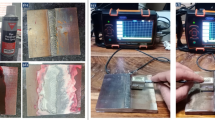Abstract
The Kachanov and Rabotnov (K-R) creep damage model was interpreted and applied to type 316LN and HT-9 stainless steels. Seven creep constants of the model,A, B. k, m, λ, γ, andq were determined for type 316LN stainless steel. In order to quantify a damage parameter, the cavity was interruptedly traced during creep for measuring cavity area to be reflected into the damage equation. For type 316LN stainless steel, λ=ε R /ε* and λ f =ε/ε R were 3.1 and increased with creep strain. The creep curve with λ=3.1 depicted well the experimental data to the full lifetime and its damage curve showed a good agreement whenr=24. However for the HT-9 stainless steel, the values of A and A/ were different as λ=6.2 and λ f =8.5, and their K-R creep curves did not agree with the experimental data. This mismatch in the HT-9 steel was due to the ductile fracture by softening of materials rather than the brittle fracture by cavity growth. The differences of the values in the above steels were attributed to creep ductilities at the secondary and the tertiary creep stages.
Similar content being viewed by others
References
Belloni, G., and Bernasconi, G., 1978, “Creep Damage Models,”Creep of Engineering Materials and Structures, Edited by Bernasconi G. and Piatti G., Applied Science Publisher LTD, London, pp. 195–227.
Belloni, G., Bernasconi, G., and Piatti, G., 1977, “Creep Damage and Rupture in A1SI 310 Austenitic Steel”,Meccanica, Vol. 12, pp. 84–96.
Brathe, L., 1978, “Macroscopic Measurements of Creep Damage in Metals,”Scand. J. Metallurgy, Vol. 7, pp. 199–203.
Cane, B. J., and Greenwood G. W., 1975, “The Nucleation and Growth of Cavities in Iron during Deformation at Elevated Temperatures,”Metal Sci., Vol. 9. pp. 50–60.
Dyson, B. F. and McLean, D., 1972, “A New Method of Predicting Creep Life,”Metal Science Journal, Vol 6, pp. 220–223.
Kachanov, L. M., 1958, “On Creep Rupture Time”,Izv. ANSSSR, OTN, No. 8., pp. 26–31.
Kachanov, L. M., 1986, Introduction to Continuum Damage Mechanics,Martinus Nijhoff Publishers, Dordrecht, pp. 1–10.
Kim, W. G., Kim, D. W., and Ryu, W. S., 2000, “Applicability of Monkman-Grant Relationships to Type 316L(N) Stainless Steel”,Transactions of the KSME (A), Vol. 24, No. 9, pp. 2326–2333.
Kim, W. G., Kim, D. W., Ryu, W. S., and Kuk I. H., 1998, “Effect of Phosphorus on the Creep Properties in AISI 316L(N) Stainless Steel”,Proc. of the Korean Nuclear Society Autumn Meeting, Seoul, pp. 216–221.
Kim, W. G., Kim D. W., and Ryu, W. S., 2001, “Creep Design of Type 316LN Stainless Steel by K-R Damage Model”,Transactions of the KSME (A), Vol. 24. No. 2, pp. 296–303.
Kim, K. Y., and Lee. K. Y., 1996, “The Life Assesment of Creep Damaged Components Used High Pressure and Temperature Condition by Metallographic Replicas”,Proc. of Materials and Fracture Part of the KSME 96MF14, Seoul, pp. 90–96.
Leckie, F. A., and Hayhurst, D. R., 1975, “The Damage Concept in Creep Mechanics”, Mech. Res. Comm., Pergamon Press., Vol. 2, pp. 23–26
Leckie, F. A., and Hayhurst, D. R., 1977, “Constitutive Equations for Creep Rupture”,Acta Metallurgical, Vol. 25, pp. 1059–1070.
Oh, Y. J., and Hong, J. H., 2000, “Nitrogen Effect on Precipitation and Sensitization in Cold-Worked Type 316L (N) Stainless Steels”,Journal of Nuclear Materials, Vol. 278, pp. 242–250.
Penny, R. K., 1974, “The Usefulness of Engineering Damage Parameters During Creep”,Metal and Materials, Vol. 8. pp. 278–282.
Penny, R. K., and Marriott, D. L., 1995, Design for Creep, Chapman & Hall, London, pp. 165–174.
Rabotnov, Y. N., 1969, Creep in Structural Members,John Wiley & Sons, New York, pp. 359–382.
Riedel, H., 1987, Fracture at High Temperature,Springer- Verlag Berlin, Heidelberg, p. 390.
Ryu, W. S., Kim, W. G., Kim, D. W., Kuk, I. H., Kim, S. H., Jang, J. S., Rhee, C. K., Chung, M. G., Park, S. D., and Han, C. H., 1998, “A State of the Art Report on LMR Structural Materials”,KAERI/AR-487/98, pp. 37–47.
Viswanathan, R., 1989, Damage Mechanisms and Life Assessment of High-Temperature Components,ASM International, Carnes Publication Services, Inc. Ohio, pp. 10–15.
Author information
Authors and Affiliations
Corresponding author
Rights and permissions
About this article
Cite this article
Kim, WG., Kim, SH. & Ryu, WS. Creep characterization of type 316LN and HT-9 stainless steels by the K-R creep damage model. KSME International Journal 15, 1463–1471 (2001). https://doi.org/10.1007/BF03185735
Received:
Revised:
Issue Date:
DOI: https://doi.org/10.1007/BF03185735




